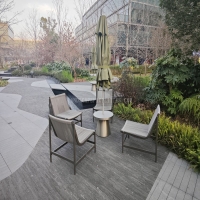Welcome to the website for landscape facilities products and knowledge.
What are the best materials for landscape tables in high-altitude environments?
When selecting materials for landscape tables in high-altitude environments, durability and weather resistance are paramount. High-altitude regions experience extreme temperature fluctuations, intense UV exposure, and heavy snowfall, which can degrade inferior materials quickly. Here are the top choices for long-lasting performance:
1. Powder-Coated Aluminum: Lightweight yet sturdy, aluminum resists rust and corrosion. A powder-coated finish adds extra protection against UV rays and scratches.
2. Teak Wood: Naturally resistant to moisture and insects, teak develops a silvery patina over time but remains structurally sound in alpine conditions.
3. Stainless Steel (Grade 304 or 316): Ideal for harsh climates, stainless steel withstands salt, moisture, and temperature swings without warping or rusting.
4. Recycled Plastic Lumber: Eco-friendly and low-maintenance, this material mimics wood but won’t splinter, rot, or fade under UV exposure.
5. Concrete with Sealant: For a modern look, sealed concrete tables resist cracking in freeze-thaw cycles and offer unmatched stability.
Pro Tip: Avoid untreated woods or thin metals—opt for materials with warranties specifically covering high-altitude use. Pair your choice with UV-resistant cushions or covers to extend longevity.
By prioritizing these materials, your landscape tables will endure the challenges of alpine environments while maintaining aesthetic appeal.
Related search:

Recommendation
Metal structure rattan chair without armrests for single person, with woven seat and backrest.